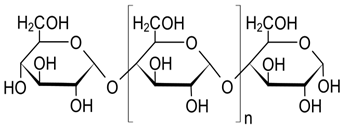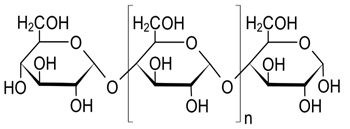Starch vs Sugar
Starch and sugars are two types of carbohydrates found in food. Carbohydrates are the organic compounds, made up of carbon (c), hydrogen (H), and oxygen (O) in the ratio of one oxygen atom and two hydrogen atoms for every one carbon atom (CH2O). This ratio is characteristic for each and every carbohydrate. For example, the sugar glucose has the chemical formula C6H12O6, where C:H:O is in the ratio of 1:2:1. Sugar is the monomer unit of complex carbohydrates. The sugar molecules are assembled to form complex carbohydrates. There are two types of carbohydrates found in food, (1) simple carbohydrates; which include sugars, and (2) complex carbohydrates; which include starches and fiber.
Starch
Starch is polysaccharides which contains long carbohydrate chains of glucose. Plants store starch as their energy source, which is used during plant growth and reproduction. Several types of starch storages are found in plants, including grains, legumes, and tubers. The two forms of starch found in plants are amylose and amylopectin. Amylose is composed of long, unbranched chains of glucose molecules, whereas amylopectin is made up of long, branched chains of glucose molecules. In plants, amylose to amylopectin ratio is about 1:4, but the proportion can vary depending on the plant species. For example, wheat flour contains a large amount of amylose, whereas the rice flour contains a large amount of amylopectin.
Sugar
Sugars are the simple carbohydrates, which contain a single sugar molecule or two joined sugar molecules. Based on that, the simple sugars can be divided into two categories; monosaccharides and disaccharides. Monosaccharides are the sugars that cannot be broken down during the digestion. The most common three types of monosaccharides are glucose, fructose, and galactose. All these sugars have the same chemical formula C6H12O6, but different atomic arrangements. Disaccharides are the sugars that contain two monosaccharide units linking together by a glycosidic bond. The three disaccharides that are important in human nutrition are sucrose (common table sugar), lactose (major sugar in milk), and maltose (product of starch digestion). These simple sugars are naturally present in fruits, milk and other foods and can act as monomers, which link together to form complex carbohydrates called polysaccharides.
What is the difference between Starch and Sugar?
• Starch is a complex carbohydrate, whereas sugar is a simple carbohydrate.
• Starch is made up of long chains of simple sugar called glucose, whereas sugar can be made up of either a single sugar molecule or two simple sugar molecules linking together by a glycosidic bond.
• Two types of starch are amylose and glycogen, whereas two types of sugars are monosaccharide and disaccharide.
• Starch can be further digested into simple sugars, unlike the sugar (monosaccharide).
• Polymerization of simple sugars (glucose) forms the starch.
• Starch is the storage source of energy, whereas sugar is the direct energy source. .
• Starch has no sweet taste, but sugar does.
• Sugar has no or single glycosidic bond, whereas starch has many glycosidic bonds.
ncG1vNJzZmivp6x7pbXFn5yrnZ6YsqOx07CcnqZemLyue8OinZ%2Bdopq7pLGMm5ytr5Wau26%2F1KCYq2WRo7Fuv9OaqZygXw%3D%3D

